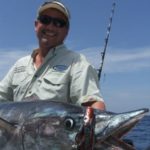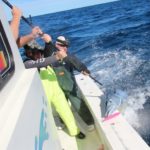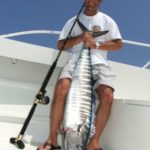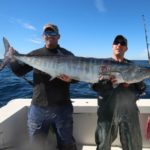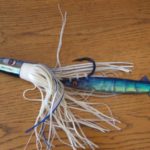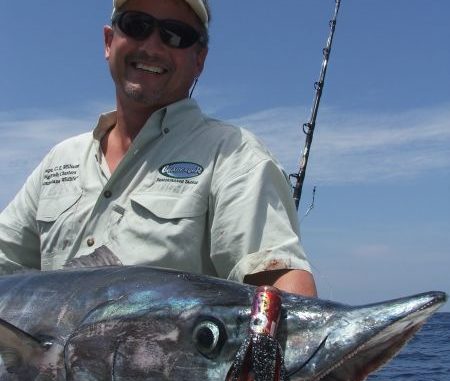
The weather should finally lay this month, and packs of wahoo are waiting just offshore. This ’hoo expert shares his secrets to success.
Offshore anglers know winter offers some of the best wahoo fishing of the year.
Unfortunately, winter is a difficult season during which to head offshore.
That’s why offshore charter captains like Tommy Pellegrin with Custom Charters out of Cocodrie can hardly wait for late February and March to roll around.
“The reason you hear more wahoo reports this time of year is because we get better weather,” Pellegrin explained. “Fishermen can actually get out to the fish, and they come back talking about wahoo.”
As some of the late-winter cold fronts push through the Gulf of Mexico, the high pressure that follows a day or two later calms the weather down enough to allow offshore boats to get to wahoo that were almost unreachable just a month or two before.
Couple an easier boat ride with the fact that the largest wahoo of the year pack-hunt bait around just about anything floating on the Gulf’s surface, and you’ve got a combination that can get people talking.
“We have wahoo all year long,” Pellegrin noted, “but they are a lot smaller during the summer. Your typical wahoo runs 20 pounds or less then — we call them snakes.
“But during this time of year, our wahoo average 30 to 50 pounds.”
The heaviest wahoo Pellegrin has ever put on his boat weighed 92 pounds, and he pointed out that 80- to 100-pound fish are not uncommon.
Larger wahoo like to feed on a steady diet of small tuna, bonita and hardtails. And to hear Pellegrin explain it, finding a congregation of small black fin tuna and bonita is just about as sure of a thing as you’re going to find when wahoo fishing.
“You can’t have predator fish without the bait,” he said. “Wahoo migratory patterns put them here this time of year, and we’ve got a great concentration of bait. The water gets nice and blue out in the area where wahoo typically like to be, and that blue water is just full of bait.”
Wahoo can be found on top of reefs and wrecks, but the wahoo wonderland is more frequently found under anything floating.
Pellegrin said the best fishing is around buoys like wreck markers and rig markers, big patches of grass and even boards — anything floating in the right zone in blue water.
“You can catch them in extremely clean green water,” he said, “but it’s mainly in the blue water. Anything floating this time of year, figure there’s going to be a wahoo there, especially if you pull up and spot a bunch of bait.”
In fact, Pellegrin’s best fishing happens when he doesn’t pull up and look at what’s under whatever he spots floating. Instead, he assumes it’s going to hold bait and wahoo, so he goes right to work.
“We throw our baits out and make our first pass, swinging wide to pull those baits right next to whatever is floating out there,” he explained. “That’s where you want that bait to be, and if a wahoo is there, he’s going to hit it.
“If there are two wahoo around, you’ll hook them both.
“If there are three wahoo around, and you got three lines out, you’ll hook all three.”
Because wahoo are pack hunters this time of year, Pellegrin recommended not stopping the boat to reel in one fish, because when one hits the next one will come out to see what’s going on.
If your other baits are still moving, he’s going to hit it.
“Now, if you got a big one on, and he’s dumping your reel, and your only choice is to stop and catch him or loose all that line, you’re going to stop,” Pellegrin explained. “But typically, in that 10 to 15 seconds after the first one hits, if you’re going to get another one he’s going to hit at that point and time.”
Pellegrin determines what speed to troll based on what baits he is fishing. Seven knots work well for deep-diving plugs. Nine knots work well for some of the lipless swimbaits. And he typically pulls surface baits from 9 to 12 knots.
Although trolling isn’t the only way to catch wahoo, Pellegrin was adamant that anybody wanting to cast for wahoo better be ready to reel quickly.
“My son Eric was out not too long ago, and they got on some blackfin tuna on bottom,” Pellegrin said. “While they were reeling in the first fish, he instinctively grabbed some chum and threw it out. In the melee, he had a big wahoo — maybe 70 or 80 pounds — come around the boat eating chum.”
Eric Pellegrin began casting a River2Sea Apex plug and ripping it as fast as he could. The wahoo reacted and bit on his third cast.
The fish ripped off all kind of line, but the younger Pellegrin missed the strike.
“There were teeth marks on the center of the bait,” Tommy Pellegrin said. “Wahoo hold baits so tight in their mouths, and their mouths are so hard that it’s hard to get a hook to penetrate. That’s what happened here.”
Because of their hard mouths, Pellegrin said wahoo are a fish that anglers must fight with absolutely no slack in their lines. In fact, if he’s not tied on to something, Pellegrin keeps the boat in gear to help keep lines as tight as possible.
“They rip out 300 yards of line and you think that hook is buried in their mouths. Then you get them to come beside the boat, they open their mouths, and the hook just falls out,” Pellegrin explained. “It’s critical to keep tight lines.”
Pellegrin keeps his line on reels that allow him to spool on 600 yards of 50-pound-test braided line because length of line is more important for wahoo fishing than some big, massive 50-size reel.
He prefers Penn Squall 40s or Penn International 12s for wahoo fishing because they hold the line and have enough drag to stop a wahoo run.
“Humans can hold back 20 pounds of drag for five to 10 minutes,” Pellegrin noted. “The history of me being on the boat, though, has proven that most guys are looking to cry and give up after about 10 minutes.
“We fish 15 pounds of drag, so 50-pound-test line is plenty for wahoo.”
Since wahoo fishing happens out in the open, fish just run where they want, and anglers don’t have to worry about rigs.
And in the 200-foot depths that Pellegrin typically fishes wahoo, fish can’t go down and beat him — so they have to go straight away to try to win the battle.
“They fight pretty good,” Pellegrin said. “Not like a tuna, but they give you a good battle. Not any long distance-type of fight; you’re looking at about a five- to 10-minute fight on a 50-pound wahoo and maybe 15 to 20 minutes on an 80-pound wahoo.
“Now if you’re the one on the line, you’re going to think it’s an hour and a half.”
Operating out of Boudreaux’s Marina in Cocodrie, Pellegrin typically runs upwards of 70 miles to get on wahoo this time of year. However, if the blue water is close enough, sometimes he can make it happen as close as 40 or 50 miles.
“We don’t have a river to run through like they do at Venice,” Pellegrin said. “They talk about running 15 miles out over there, but they’ve already run 30 miles of river by the time they hit the Gulf.”
Don’t get too caught up in depth and distance, though. Wahoo really don’t care about depth as much as they do the bait and water clarity. In fact, heading out of Grand Isle or Port Fourchon, anglers might find really clean water loaded with bait at 100 feet.
Although wahoo fishing is never over, it does slow down come April, when the water temperature creeps to the upper 70s and lower 80s.
“When it gets that high, you can figure wahoo fishing has slacked off,” Pellegrin said. “Come April, we’re typically not looking for wahoo too much. We may catch a couple in an area we’re fishing, but we’re not going after them. They just kind of show up.”
So if you’re looking to take advantage of Louisiana’s wahoo wonderland, pick a good day under a high pressure after a front and make the run.
Just remember that the first day of spring this year is March 20. That’s getting close to the time the wintertime wahoo bite will start to slack off.
Until then, the wahoo bite will be the best it’s going to be all year.
Contact Capt. Tommy Pellegrin at 985-851-3304 or highlife@customchartersllc.com.
